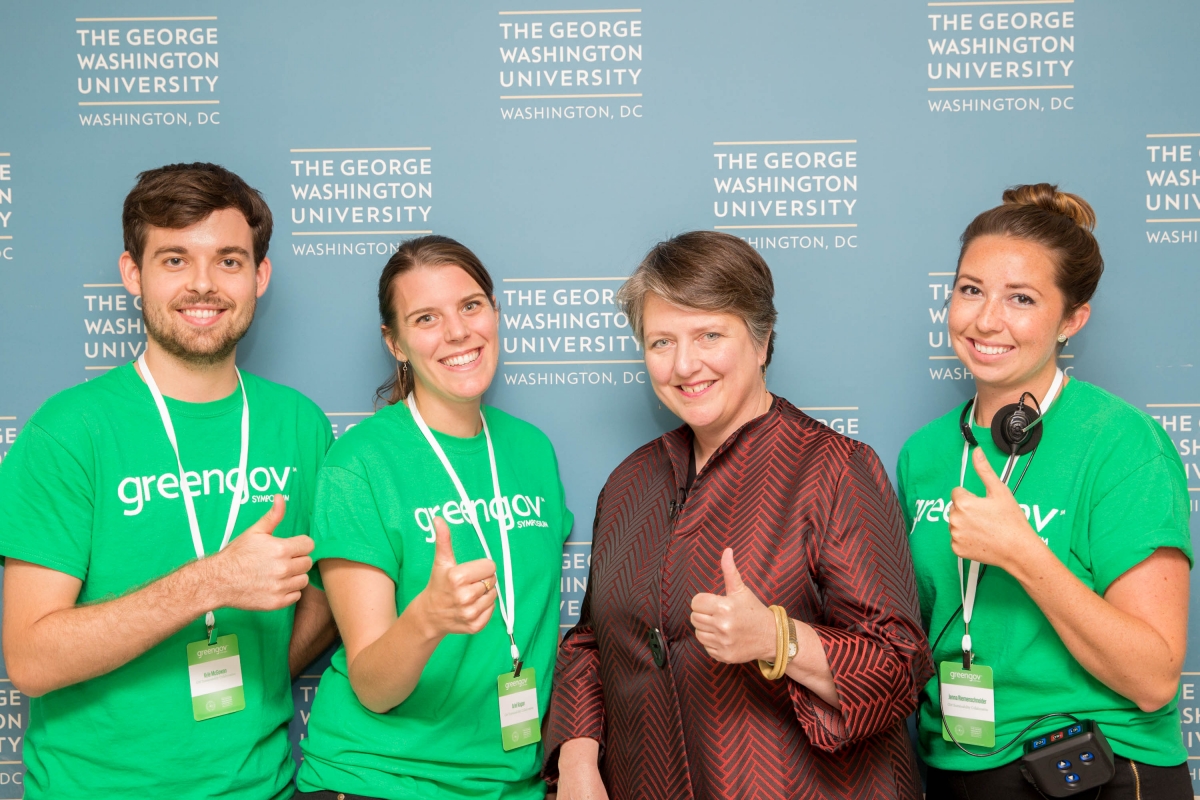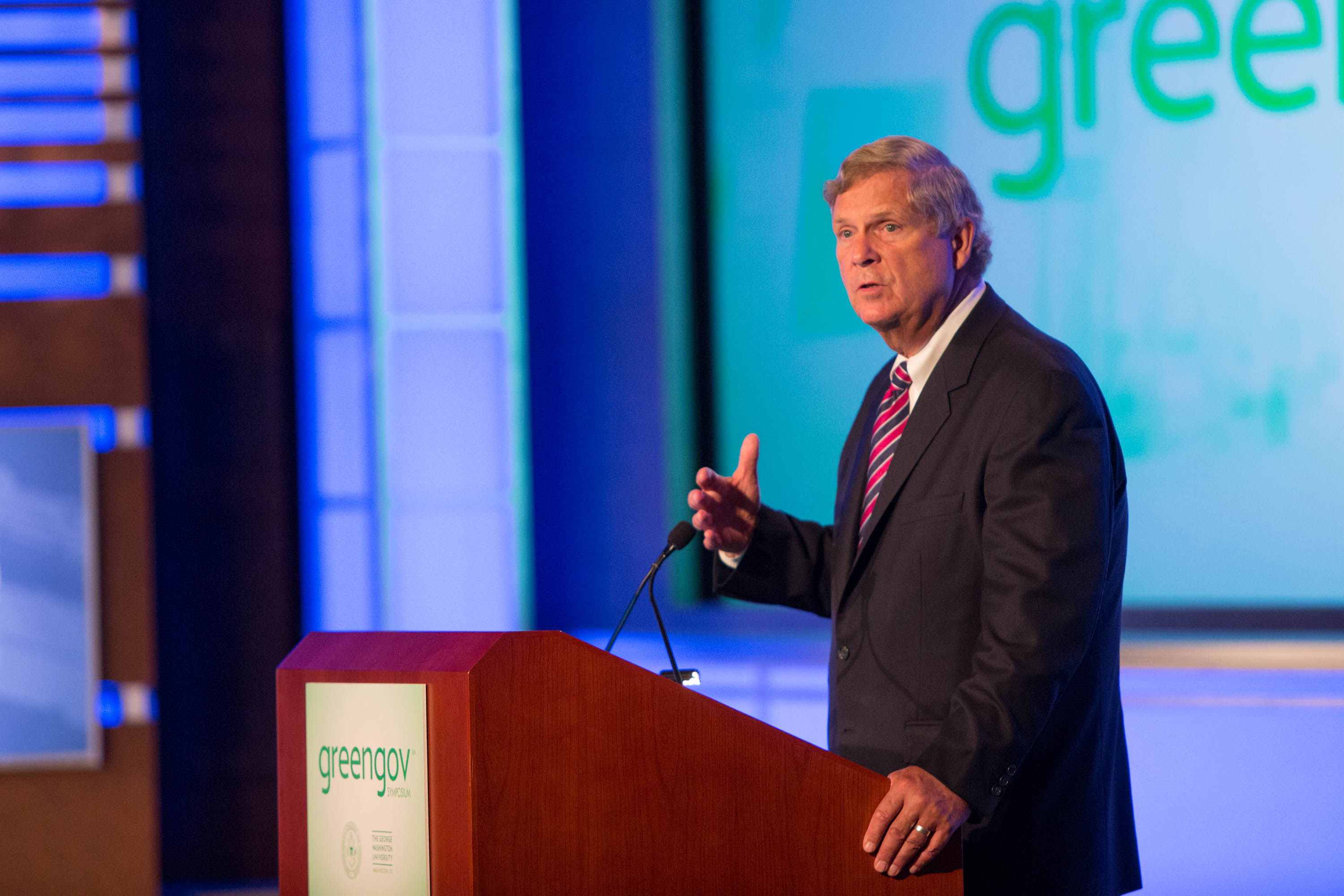By Brenda Wilson
“The federal government buys a lot of stuff,” U.S. Secretary of Agriculture Tom Vilsack told a capacity crowd last Thursday, as the keynote speaker at George Washington University’s daylong GreenGov Symposium that was held in partnership with the White House Council on Environmental Quality.
Secretary Vilsack, the longest-serving cabinet member who was sworn in the same day as President Obama, was promoting the administration’s policy on sustainability as a means of preserving natural resources for future generations, protecting the environment and mitigating the effects of climate change.
The federal government is the country’s greatest consumer, with facilities around the country spending more than $400 billion annually, Secretary Vilsack said.
The government can set an example and move the economy in a new direction by opting for the thousands of bio-based goods and services now available, including fuel, clothing, solvents, cleaners, lubricants, materials, fabrics and fibers of all kinds.
“We want American consumers to understand when they see that bio-based label, they are in a position to make a difference,” Secretary Vilsack said.
As important as these products are to the environment and the economy, he said they are essential to national security, offsetting the United States’ reliance on oil from the Persian Gulf that puts in jeopardy young men and women in the U.S. military.
He singled out the Navy as one of the administration’s best partners for taking steps to meet 50 percent of its fuel needs with a bio-based fuel mix. Along with the Department of Energy’s support, he said, this has created an industry that didn’t exist, one the commercial aviation industry is buying into to reduce emissions.
Recent droughts in California, floods in Louisiana and other parts of the southern U.S., as well as rising sea levels around New York and in the Caribbean have heightened concerns about changes in climate that result from burning fossil fuels, heightening interest in environmental issues.
The U.S. Department of Agriculture has developed 10 “building blocks” to address the impact of climate change as it relates to water quality and quantity. Farmers, as well as forest and mine owners, are being instructed about new crop management systems, diversity, rotation and cover crops to promote soil health and manage water more effectively. A recently announced $26.6 million innovative grants program, Secretary Vilsack said, provides funding to states, localities, private businesses and nonprofit organizations that work with farmers on conservation.
Secretary Vilsack was particularly enthusiastic about a government program jointly funded with the Softwood Lumber Council to promote the use of wood in construction and architecture as a more energy-efficient material. Building with wood also removes from the environment millions of acres of dead trees killed off by harsh weather and destructive pests that lead to devastating forest fires in the West.
“So you have the capacity in purchasing bio-based products, thinking creatively about building materials and looking for creative ways to use your agency’s powers to facilitate this bio-based economy, this green economy,” he said.
Kathleen Merrigan, executive director of sustainability at GW, who served as Secretary Vilsack’s deputy secretary for four years, said sustainability goals have not yet been met—just 2 percent of the 26 percent reduction in emissions the Obama administration agreed to in the Paris 2015 climate accords.

Kathleen Merrigan, executive director of sustainability, and GW's GreenGov team. (Logan Werlinger/GW Today)
There needs to be greater awareness of the power of federal managers to do good, Dr. Merrigan said, if the administration hopes to achieve the goals set by the president’s executive order on sustainability.
The audience questioned whether agriculture was being diverted from food production to grow bio-based products and how federal subsidies for industrialized farms align with the government’s innovations on sustainability.
In response, Secretary Vilsack said, “The bio industry is not taking food out of the mouths of babies.” Instead, production of corn, for example, has increased to meet the needs for fuel, food and export. He reminded them that the small amount American households spend on food compared to the rest of the world is possible because of large-scale farms.
He blamed a misunderstanding of the bio industry on the media, which he said doesn’t do a good job reporting on it, and an oil industry that feels threatened by its growth.
“There is something happening in America where we are creating more opportunity where this notion of sustainability is now something that is valuable to us as a country and as a people. That permeates rural America and family farm operations. They’re looking for ways to be better stewards,” he said.
GW President Steven Knapp provided welcoming remarks at the event, noting that sustainability is one of the university’s core values and in the last several years has focused on sustainability research and courses, as well as sustainable operations and a partnership in a renewable energy project that allows GW to source 50 percent of its power from solar energy.
“We really are here to help serve the federal government as well as any other partners who are interested in benefitting from the talents and energies of our students, who serve as interns in many of your agencies, and also the expertise we can provide as we focus on urban sustainability and its connection with global sustainability,” Dr. Knapp said.
Managing Director of the White House Council on Environmental Quality Christy Goldfuss, as well as chef Dan Barber, also provided remarks.
Also at the event, Dr. Merrigan discussed the new case studies released by GW.
The five case studies—covering topics such as waste, power purchase agreements and fleet electrification—include write-ups, pictures, video content, and interviews to explore the issues, opportunities, challenges and decision points associated with meeting sustainability challenges.
The cases are provided as open-access training materials to help accelerate understanding of sustainability needs and opportunities. Initially, they were developed as training materials for managers in the U.S. federal government seeking to achieve the goals set forth by the executive order Planning for Federal Sustainability in the Next Decade. However, the training materials are valuable to a broad range of leaders in state and city government, and the private and non-profit sectors.


